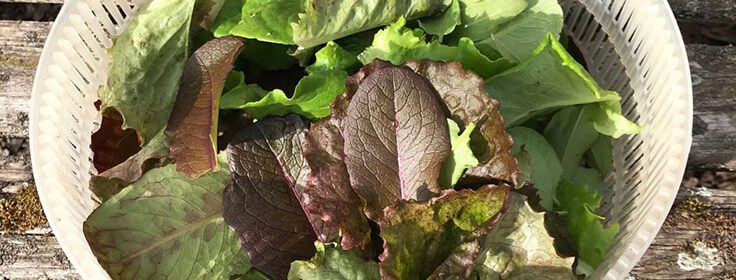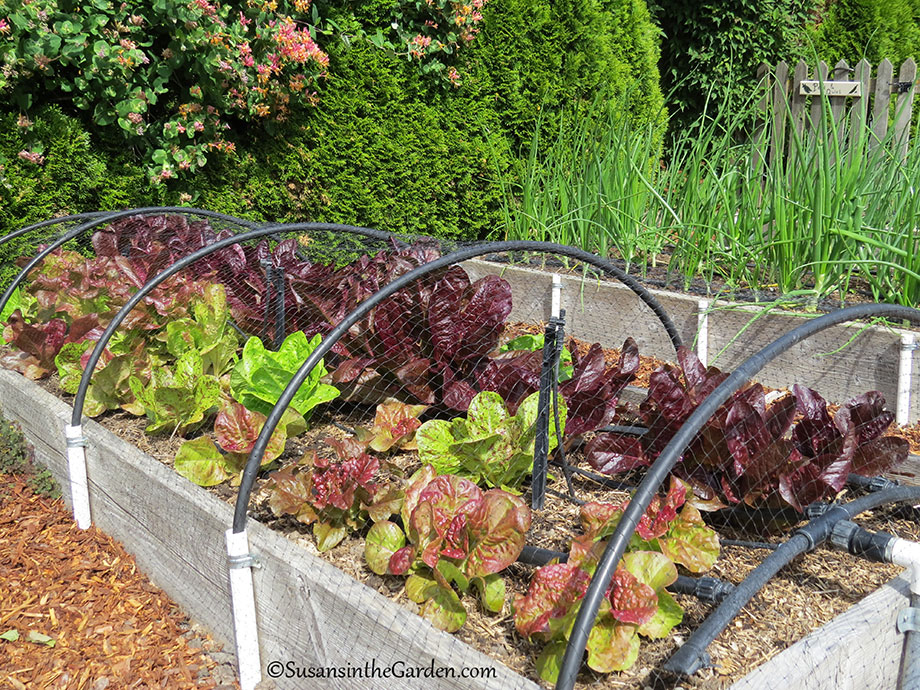March 6 Column: Growing Lettuce

I can’t believe it’s time for my third garden column of the season already! The topic is on growing lettuce because I had a lot of tips and information that I wanted to share with you.
In it, you’ll learn about my favorite varieties, when I plant them, and an early planting technique that worked great for me last year. Other important information includes dealing with slugs and critters that also want to eat your plants. You can read my column in today’s edition of The Spokesman-Review: Give lettuce an early start inside for spring salads. Or you can read the text of my column underneath the video.
The main thing I want to stress is that growing lettuce is easy and boy, does homegrown lettuce make for great salads!
What’s in this week’s video? I thought it would be helpful to go through the vegetable varieties I’m growing this year. This includes why I’ve chosen them… oh yeah, and some that Bill has chosen! (he always likes to weigh in on this, you know) In addition, you’ll find out about a new product we’re going to try this year. I hope you’ll enjoy the video!
Here is the garden column:
by Susan Mulvihill
Who’s in the mood for a tasty, homegrown salad right now? Lettuce and other types of salad greens are the powerhouses of the spring garden because they grow quickly and abundantly.
Lettuce is a cool-season crop. In the Inland Northwest, you can plant the seeds about a month before our average last frost date of May 15. These plants thrive in cooler weather. Once our summertime temperatures really heat up, the leaves will become bitter and the plants will bloom, set seed and die. Fortunately, you can sow them again in late summer and grow them well into the colder months of the year.
Last fall, I grew a new variety called Batavia Full Heart endive and was amazed by how cold-tolerant it was. Because the leaves are a bit thicker than regular lettuce, the slugs even left them alone. I’ll definitely plant this variety again this fall.
I’ve long maintained that the most difficult aspect of growing lettuce is selecting a few varieties from the hundreds of cultivars available. My longtime favorites include ‘Red Sails’, ‘Speckled Trout’, ‘Bronze Beauty’, ‘Red Romaine’ and ‘Buttercrunch’. This year I’m trying a new variety called ‘Crisp Mint’. I know that sounds like a strange name for lettuce but it’s a compact Romaine type with frilly-edged leaves that resemble mint foliage.
Last year, I started some lettuce plants indoors, transplanted them out in the garden on April 1 and immediately covered them with a clear plastic cloche tunnel. This enabled me to begin harvesting leaves about a month earlier than usual. This year, I started new plants indoors on Jan. 27 and am hoping to transplant the seedlings even earlier. (Susan’s note: I’ve inserted the video from last year’s lettuce project below the end of my column)
If you would like to try this as well, I recommend starting your seeds indoors right away. When it comes time to transplant them, you can cover each plant with an empty plastic milk jug with the bottom removed. Another option is to create a low tunnel, which involves setting up a series of hoops and suspending clear plastic sheeting over the seedlings to keep them warm. Keep an eye on them to make sure the leaves don’t get burned on sunny days.
You can also plant lettuce seeds directly into the garden in early to mid-April. No matter which method you use, it’s important to space your plants appropriately so they have plenty of room to grow. Most lettuce plants need about 12 inches. Remember to eat your thinned seedlings.
In order to get a lengthy harvest season, use the “cut and come again” method. To do this, pick the outer leaves rather than entire plants. They will continue producing new leaves.
Do you have critters in your garden that appreciate salad greens just as much as you do? Certain types of birds — primarily finches and California quail – like to nibble on our plants so I always cover the bed with bird netting suspended over hoops. Chicken wire enclosures are another option.
Slugs can also be an issue. There are plenty of control options if this occurs: hand-picking, sprinkling diatomaceous earth on the soil surface, or creating beer traps from empty tuna cans, sinking them into the soil and partially filling them with beer. Slugs are attracted to the smell of the yeast, lean over the can’s edge, fall in and drown.
If the forecast calls for warmer-than-usual temperatures early on, I’ll place shade cloth above the lettuce bed to provide the plants with some relief.
Susan Mulvihill is author of “The Vegetable Garden Pest Handbook.” She can be reached at Susan@Susansinthegarden.com. Watch this week’s video at youtube.com/susansinthegarden.

